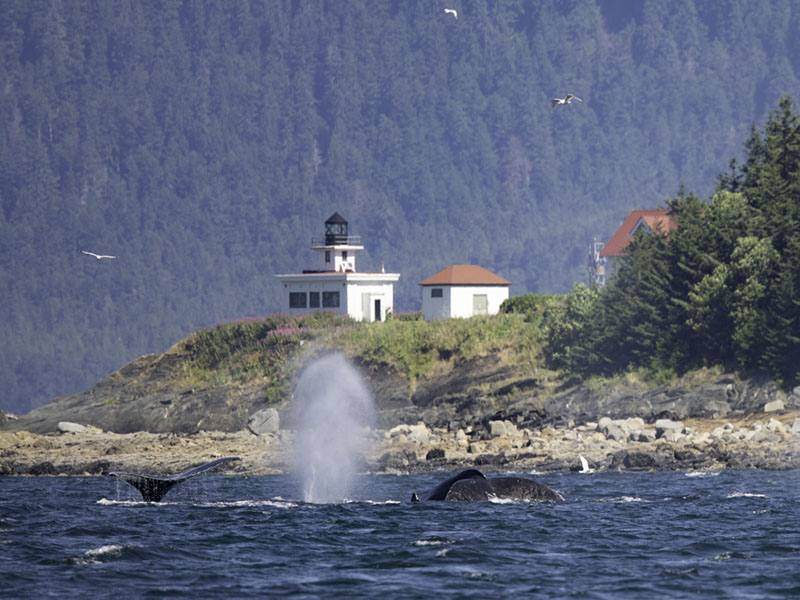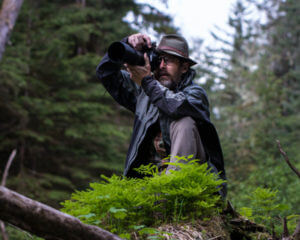Fish in a Barrel: Humpback Whales coming together in Juneau, Alaska

It is mid-summer in Southeast Alaska, near Juneau, where a large flock of gulls is floating in Lynn Canal—the deepest inland fiord in North America. If you encountered this raft of birds, you might logically think they are just resting, being social, or finding safety in numbers. And, maybe, you would be right.
When, suddenly, they all take off at once, you might logically look for a threat that sent them into the air—an eagle attacking from above or, perhaps, some marine mammal or another who threatens them from below.
If, indeed, you are thinking marine mammal, you are right, but the mammal driving this flight is not a threat to the gulls. These seabirds are not prey, but predators, taking advantage of the work of another, much larger predator. You might call the gulls, predatory opportunists.
The drama the gulls are taking part in is not something I usually talk about with the guests on my tours. In fact, I don’t talk about it ever, unless we see it. This is not because I am superstitious; I don’t think that mentioning it will prevent us from seeing it. My silence is all about setting—or, not setting—expectations.
If I took you out for your first raw oysters, and spent my time talking about the possibility of finding a pearl in your appetizer, you would have an unreasonable expectation. Even though finding a pearl in an oyster is always possible, it is very unlikely, and as the host of your oyster dining experience, I would want to set you up for a culinary delight, not a failed treasure hunt.
Living in Juneau, I see gulls every day. They are everywhere, scavenging for whatever meal they can acquire with the least possible effort, be it dead fish on the beach, or french fries in the fast-food parking lot. May through October, in my job as a whale-watching guide, I also see humpback whales daily, though neither on the beach, nor the parking lot.
Unlike the gulls, we rarely see humpback whales actually feeding, because their food is found beneath the surface of the ocean. Humpbacks spend most of their time alone, diving deep in the cold waters of the Pacific for herring or krill. Only between these feeding dives do they reveal themselves to us by spout, by dorsal fin, and by fluke.
A parking lot scavenger and a deep-diving predator might seem the least likely of allies, but on this day, humpback whales are just what gulls are looking for. The usually solitary whales have come together to put on one of the greatest shows on earth. We call the show bubble-net feeding. Gulls see it as a fresh fish buffet!
Several whales, working together, herd a school of herring into a tight group. Beneath the school, a single whale circles, releasing air from her massive lungs to form a cylinder of bubbles up and around the fish. The herring are disoriented, and trapped. A call is made and a surge of humpback whales—each one roughly the size of a school bus—rushes upward through the confused school. They are, quite literally, hunting fish in a barrel made of bubbles.
The gulls, having heard the call, race toward the scene. From our boat, we look in the direction they are heading, to see an arc of bubbles breaking the surface and quickly scribing a circle. As the seagulls arrive, so do the whales. A phalanx of gaping jaws lined with shaggy baleen explodes through the surface of the water. Herring, frantically escaping the onslaught, are snatched up by hungry gulls.
I stand with the guests on my tour, slack-jawed by the performance, often teary-eyed, with nothing to say.
As a guide, I pride myself in doing the hard work of connecting dots for my guests—showing the interconnectedness of everything from whales and herring, to glaciers and salmon, to wasps and willow trees.It is hard work on even the best of days, but every now and then, in the midst of the work, a pearl of great price shows up in our oysters and makes my job, for a moment, easy. And sometimes, it is lowly gulls who show me the way to the pearl.

About the Author: Jim Pfitzer is about to begin his second season as a guide for Gastineau, and his second year as an an Alaskan. He was born and raised in Chattanooga, TN, but has moved all over the country pursuing wild places and even wilder experiences. When asked about himself, Jim says he would rather paddle a canoe than drive a car, and prefers watching birds to watching television. “That about sums me up,” he says.

